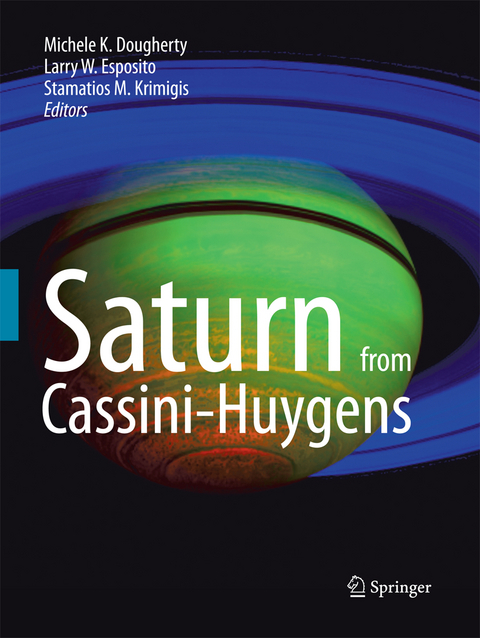
Saturn from Cassini-Huygens
Springer (Verlag)
978-94-017-8088-9 (ISBN)
Michele Dougherty, Cassini Saturn Orbiter (NASA/ESA) - Acting Principal Investigator (PI) for magnetometer instrument. Dr. Esposito the principal investigator of the Ultraviolet Imaging Spectrograph (UVIS) experiment on the Cassini space mission to Saturn. He was chair of the Voyager Rings Working Group. As a member of the Pioneer Saturn imaging team, he discovered Saturn’s F ring. He has been a participant in numerous US, Russian and European space missions and used the Hubble Space Telescope for its first observations of the planet Venus. He was awarded the Harold C. Urey Prize from the American Astronomical Society, The NASA Medal for Exceptional Scientific Achievement, and the Richtmyer Lecture Award from the American Association of Physics Teachers and the American Physical Society. Dr. Esposito has written his Ph.D dissertation, numerous scientific publications, scholarly reviews on the topic of planetary rings as well as the Cambridge University Press book Planetary Rings. Along with his students and colleagues he continues to actively research the nature and history of planetary rings at the University of Colorado, where he has been since 1977. He is now Professor of Astrophysical and Planetary Sciences and a member of the Laboratory for Atmospheric and Space Physics (LASP). He has been an officer of the Division for Planetary Sciences of the American Astronomical Society and of the Committee for Space Research (COSPAR) of the International Council of Scientific Unions. He was chair of the National Academy of Sciences Committee on Planetary and Lunar Exploration (COMPLEX). He is a member of American Astronomical Society, American Geophysical Union and International Astronomical Union. Dr. Stamatios (Tom) Krimigis has been at APL since 1968, after earning his B. Physics from the University of Minnesota (1961), and his M.S. (1963) and Ph.D. (1965) in Physics from the University of Iowa and serving as AssistantProfessor of Physics and Astronomy there. He became Supervisor of Space Physics and Instrumentation in the Space Department, Chief Scientist in 1980, Department Head in 1991, and Emeritus Head in 2004. He is Principal Investigator on several NASA spacecraft, including Voyagers 1 and 2 to the Outer Planets and the Voyager Interstellar Mission, and the Cassini mission to Saturn and Titan. He has designed and built instruments that have flown to seven of the nine planets, and hopes to complete the set with his participation in the MESSENGER mission to Mercury and New Horizons mission to Pluto. He has published more than 370 papers in journals and books on the physics of the sun, interplanetary medium, planetary magnetospheres, and the heliosphere. He is recipient of NASA's Exceptional Scientific Achievement Medal twice, is a Fellow of the American Physical Society, American Geophysical Union, and American Association for the Advancement of Science, recipient of COSPAR's Space Science Award in 2002, a recipient of the Basic Sciences Award of the International Academy of Astronautics where he serves on the Board of Trustees, and was elected recently to the newly established chair of "Science of Space" of the Academy of Athens.
Overview.- Review of Knowledge Prior to the Cassini-Huygens Mission and Concurrent Research.- Origin of the Saturn System.- The Interior of Saturn.- Saturn: Composition and Chemistry.- Saturn Atmospheric Structure and Dynamics.- Clouds and Aerosols in Saturn's Atmosphere.- Upper Atmosphere and Ionosphere of Saturn.- Saturn's Magnetospheric Configuration.- The Dynamics of Saturn's Magnetosphere.- Fundamental Plasma Processes in Saturn's Magnetosphere.- Auroral Processes.- The Structure of Saturn's Rings.- Dynamics of Saturn's Dense Rings.- Ring Particle Composition and Size Distribution.- Diffuse Rings.- Origin and Evolution of Saturn's Ring System.- The Thermal Evolution and Internal Structure of Saturn's Mid-Sized Icy Satellites.- Icy Satellites of Saturn: Impact Cratering and Age Determination.- Icy Satellites: Geological Evolution and Surface Processes.- Enceladus: An Active Cryovolcanic Satellite.- The Cassini Extended Mission.- Saturn's Exploration Beyond Cassini-Huygens.- Cartographic Mapping of the Icy Satellites Using ISS and VIMS Data.
From the reviews:
“In Saturn from Cassini-Huygens, editors Dougherty (Imperial College, UK), Esposito (Univ. of Colorado), and Krimigis (Johns Hopkins) present a comprehensive volume that summarizes for Saturn, its ring system, and most of its moons the data obtained and the analysis done to date from this four-year mission. … This volume provides an advanced student or practicing researcher an excellent overview of the current state of understanding of Saturn, its rings, and many of its moons. Summing Up: Highly recommended. Upper-division undergraduates and above.” (C. Palma, Choice, Vol. 47 (10), June, 2010)
| Erscheint lt. Verlag | 23.11.2014 |
|---|---|
| Zusatzinfo | VIII, 805 p. |
| Verlagsort | Dordrecht |
| Sprache | englisch |
| Maße | 210 x 279 mm |
| Themenwelt | Naturwissenschaften ► Geowissenschaften ► Geologie |
| Naturwissenschaften ► Physik / Astronomie ► Angewandte Physik | |
| Naturwissenschaften ► Physik / Astronomie ► Astronomie / Astrophysik | |
| Technik ► Luft- / Raumfahrttechnik | |
| ISBN-10 | 94-017-8088-9 / 9401780889 |
| ISBN-13 | 978-94-017-8088-9 / 9789401780889 |
| Zustand | Neuware |
| Haben Sie eine Frage zum Produkt? |
aus dem Bereich


